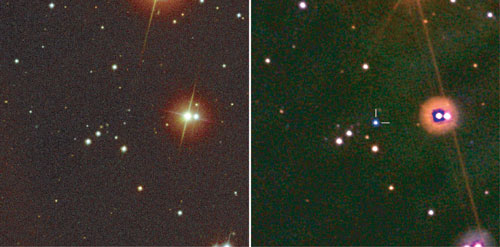 |  |  |  |  | Scientists Detect New Kind of Cosmic Explosion
|
02.23.06
|
Scientists using NASA's Swift satellite have detected a new kind of cosmic explosion. The event appears to be a precursor to a supernova, which is expected to reach peak brightness in one week.

Image above: Scientists are studying a strange explosion that appeared on February 18, 2006, about 440 million light years away in the constellation Aries. The "before" image on the left is from the Sloan Digital Sky Survey. The "after" image on the right is from NASA Swift's Ultraviolet/Optical Telescope. The pinpoint of light from this star explosion outshines the entire host galaxy. Most other sources are foreground stars. Each image is 5 arcminutes by 5 arcminutes. Coordinates for this burst are as follows: RA: 03:21:39.71 Dec: +16:52:02.6 + Click for high res (8.7 Mb) image. Credit: SDSS (left), NASA/Swift/UVOT (right)
Scores of satellites and ground-based telescopes are now trained on the sight, watching and waiting. Amateur astronomers in the northern hemisphere with a good telescope in dark skies can also view it.
The explosion has the trappings of a gamma-ray burst, the most distant and powerful type of explosion known. Yet this explosion, detected on February 18, was about 25 times closer and 100 times longer than the typical gamma-ray burst. And it possesses characteristics never seen before.
"This is totally new and unexpected," said Neil Gehrels, Swift principal investigator at NASA's Goddard Space Flight Center in Greenbelt, Md. "This is the type of unscripted event in our nearby universe that we hoped Swift could catch."
The explosion, called GRB 060218 after the date it was discovered, originated in a star-forming galaxy about 440 million light-years away toward the constellation Aries. This is the second-closest gamma-ray burst ever detected, if indeed it is a true burst.
 Image right: The collapsing star scenario that is one of the leading contenders as the cause of gamma-ray bursts. Dr. Stan Woosley of the University of California at Santa Cruz proposed the collapsar theory in 1993. This artist's concept of the collapsar model shows the center of a dying star collapsing minutes before the star implodes and emits a gamma-ray burst that is seen across the universe. Credit: NASA/Dana Berry Image right: The collapsing star scenario that is one of the leading contenders as the cause of gamma-ray bursts. Dr. Stan Woosley of the University of California at Santa Cruz proposed the collapsar theory in 1993. This artist's concept of the collapsar model shows the center of a dying star collapsing minutes before the star implodes and emits a gamma-ray burst that is seen across the universe. Credit: NASA/Dana Berry
The burst of gamma rays lasted for nearly 2,000 seconds; most bursts last a few milliseconds to tens of seconds. The explosion was surprisingly dim, however, suggesting that scientists might be viewing the event slightly off-axis. Yet this is just one explanation on the table. The standard theory for gamma-ray bursts is that the high-energy light is beamed in our direction.
"There are still many unknowns," said John Nousek, the Swift mission director at Penn State University, State College, Penn. "This could be a new kind of burst, or we might be seeing a gamma-ray burst from an entirely different angle. This off-angle glance --- a profile view, perhaps --- has given us an entirely new approach to studying star explosions. Had this been farther away, we would have missed it."
A team at Italy's National Institute for Astrophysics (INAF) has found hints of a budding supernova. Using the European Southern Observatory's Very Large Telescope in Chile, the scientists have watched the afterglow of this burst grow brighter in optical light. This brightening, along with other telltale spectral characteristics in the light, strongly suggests that a supernova is unfolding.
"We expected to see the typical featureless spectrum of a gamma-ray burst afterglow, but instead we found a mixture between this and the more complex spectrum of a supernova similar to those generally observed weeks after the gamma-ray burst," said Nicola Masetti of INAF's Institute for Space Astrophysics and Cosmic Physics (IASF) in Bologna. "A supernova must be in the works."
Masetti said this could be a Type Ic supernova, characterized by its massive size and the abundance of certain chemical elements. This implies a scenario in which a very massive star has collapsed into a black hole and subsequently exploded; the debris from the explosion is trapping optical light inside and as the dust settles, more and more light will break free.
If they are correct, scientists will have an unprecedented view of a supernova from start to finish across many wavelengths, from radio through X-ray. Radio telescopes in fact have seen this burst from the day it was detected, another first.
Because the burst was so long, Swift was able to observe the bulk of the explosion with all three of its instruments: the Burst Alert Telescope, which detected the burst; and the X-ray Telescope and Ultraviolet/Optical Telescope, which provide high-resolution imagery and spectra across a broad range of wavelengths.
Scientists will attempt observations with the Hubble Space Telescope and Chandra X-ray Observatory. Amateur astronomers in dark skies might be able to see the explosion with a 16-inch telescope as it hits 16th magnitude brightness.
Goddard manges Swift. Swift is a NASA mission with the participation of the Italian Space Agency and the Particle Physics and Astronomy Research Council in the United Kingdom.
Christopher Wanjek
Goddard Space Flight Center
|
|  |
